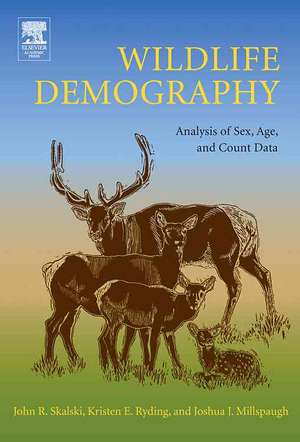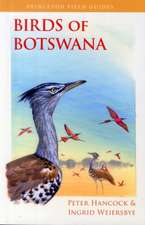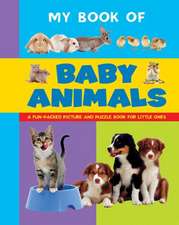Wildlife Demography: Analysis of Sex, Age, and Count Data
Autor John R. Skalski, Kristin E. Ryding, Joshua Millspaughen Limba Engleză Hardback – 7 noi 2005
The authors focus on estimation techniques using sex and age ratios because this data is relatively easy to collect and commonly used by wildlife management.
- Applicable to a wide array of wildlife species, including game and non-game birds and mammals
- Features more than 100 annotated examples illustrating application of statistical methods
- Includes more than 640 references of the analysis of nontagging data and the factors that may influence interpretation
- Derives historical and ad hoc demographic methods in a modern statistical framework
Preț: 438.85 lei
Preț vechi: 477.00 lei
-8% Nou
Puncte Express: 658
Preț estimativ în valută:
83.98€ • 87.85$ • 69.76£
83.98€ • 87.85$ • 69.76£
Carte tipărită la comandă
Livrare economică 26 martie-09 aprilie
Preluare comenzi: 021 569.72.76
Specificații
ISBN-13: 9780120887736
ISBN-10: 0120887738
Pagini: 656
Dimensiuni: 184 x 260 x 33 mm
Greutate: 1.56 kg
Editura: ELSEVIER SCIENCE
ISBN-10: 0120887738
Pagini: 656
Dimensiuni: 184 x 260 x 33 mm
Greutate: 1.56 kg
Editura: ELSEVIER SCIENCE
Public țintă
Wildlife biologists, Environmental statisticians, Quantitative ecology studentsCuprins
Ch. 1: Introduction
Ch. 2: Primer on Wildlife Population Dynamics
Ch. 3: Estimating Population Sex Ratios
Ch. 4: Estimating Productivity
Ch. 5: Estimating Survival
Ch. 6: Estimating Harvest and Harvest Mortality
Ch. 7: Estimating the Rate of Population Change
Ch. 8: Analysis of Population Indices
Ch. 9: Estimating Population Abundance
Ch.10: Integration of Analytical Techniques
Ch.11: Literature Cited
Appendix A: Statistical Concepts and Theory
Appendix B: Glossary of Symbols
Appendix C: Program USER
Appendix D: Mathematica Code for Calculating the Variance of the Finite Rate of Population Change, VAR, from a Matrix Population Model
Ch. 2: Primer on Wildlife Population Dynamics
Ch. 3: Estimating Population Sex Ratios
Ch. 4: Estimating Productivity
Ch. 5: Estimating Survival
Ch. 6: Estimating Harvest and Harvest Mortality
Ch. 7: Estimating the Rate of Population Change
Ch. 8: Analysis of Population Indices
Ch. 9: Estimating Population Abundance
Ch.10: Integration of Analytical Techniques
Ch.11: Literature Cited
Appendix A: Statistical Concepts and Theory
Appendix B: Glossary of Symbols
Appendix C: Program USER
Appendix D: Mathematica Code for Calculating the Variance of the Finite Rate of Population Change, VAR, from a Matrix Population Model
Recenzii
"The author's exhaustive treatment of analytical techniques including listing assumptions, strengths and limitations, example calculations, and decision trees, makes this text an excellent reference for any advanced wildlife student or professional. It is an excellent compendium that replaces an entire file drawer of reprints I have accumulated over the past 25 years." --Robert A. Garrott, Montana State University, Bozeman
"Methodological progress in wildlife population ecology, like temporal change in taxonomic diversity, can be characterized as “punctuated equilibrium, with long periods of stasis and slow growth punctuated by short periods of rapid development. Synthetic monographs and books have catalyzed these periods of rapid development, providing updated starting points upon which extensions and new models are based. Wildlife Demography will provide such a synthetic basis for methods based on sex and age ratio data and should lead to rapid progress in approaches that combine these and other data types for improved demographic inference." --James D. Nichols, Patuxent Wildlife Research Center, USGS
"This book provides a comprehensive introduction to techniques for estimating demographic parameters with sex, age and count data. It is unique in that it focuses solely on these approaches, using data that can often be obtained very cost-effectively and that are routinely collected by many wildlife agencies. Strengths of the book include careful lists of assumptions for each method with concrete examples to illustrate their application and a final chapter that demonstrates how multiple sources of data can be effectively combined using joint-likelihoods. This book will make an excellent textbook for students of wildlife demography and will serve as a useful reference for practicing wildlife biologists and managers." --Mark S. Udevitz, USGS Alaska Science Center, Anchorage
"Methodological progress in wildlife population ecology, like temporal change in taxonomic diversity, can be characterized as “punctuated equilibrium, with long periods of stasis and slow growth punctuated by short periods of rapid development. Synthetic monographs and books have catalyzed these periods of rapid development, providing updated starting points upon which extensions and new models are based. Wildlife Demography will provide such a synthetic basis for methods based on sex and age ratio data and should lead to rapid progress in approaches that combine these and other data types for improved demographic inference." --James D. Nichols, Patuxent Wildlife Research Center, USGS
"This book provides a comprehensive introduction to techniques for estimating demographic parameters with sex, age and count data. It is unique in that it focuses solely on these approaches, using data that can often be obtained very cost-effectively and that are routinely collected by many wildlife agencies. Strengths of the book include careful lists of assumptions for each method with concrete examples to illustrate their application and a final chapter that demonstrates how multiple sources of data can be effectively combined using joint-likelihoods. This book will make an excellent textbook for students of wildlife demography and will serve as a useful reference for practicing wildlife biologists and managers." --Mark S. Udevitz, USGS Alaska Science Center, Anchorage





